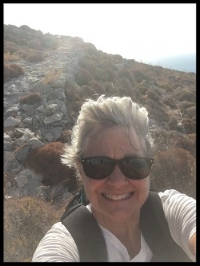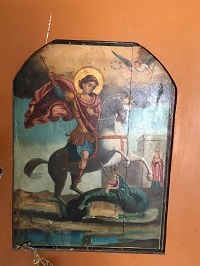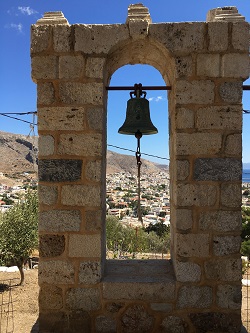Ares, Greek god of war
Are humans inherently violent?
As an instructor of physical and cultural anthropology, I asked my students to answer this question every semester. Responses varied. Discussion was insightful.
From an ancient Greek perspective, war was ever-present and demanded a god to reign over it. Included among the powerful Olympian twelve was Ares god of war.
Throughout my lifetime, and my parents’ lifetimes, and my grandparents’, back to the dawn of civilization and well before it, humanity has found cause and means to harm itself. Are humans inherently violent?
As of this writing, the world waits. Will yet another war of words turn to violence? And Why? The question has been asked so many times. Why? Land, religion, power, and we mustn’t forget Helen of Troy.
In the month I have spent exploring this Aegean island of Kalymnos, I see evidence of conflict everywhere. The structures of aggression and fortification date back through the Bronze Age (2000 B.C.), perhaps even into the Neolithic period, although not yet quite proven. Ares stands tall here, commanding the mountain tops and watching for opportunities.
What strikes me is the island is very rugged, not well-suited to agriculture, barren of prized minerals, ores, or other resources of value. Aside from its beauty, it seems it would offer nothing to those who thirsted after this tiny piece of the world. Its early inhabitants must have endured a life of struggle. Even the water is permeated with brine requiring rainwater harvesting.
Goats welcome me before my ascent to Chorio. I know they have always been here.
The goats love it, but what has been the attraction to invaders? The answer: it lies in a strategic pathway. Kalymnos’s unlucky proximity to its larger sister islands, Kos and Rhodes, and only 35 miles from Turkey have made it a prime target for attack and occupation.
Ares Insatiable Wrath
One of the earliest references to Kalymnians at war comes from the blind poet Homer in the Iliad. In it, he mentions their participation in the Trojan War. The Persians (now Iran) took control of the island during the Persian War, then passed it on over to Artemisia I, queen of Halicarnassus (now Bodrum, Turkey). Later, freed by the Athenians, the island fought beside them during the Peloponnesian War, but then found itself again occupied, this time by Artemisia II. Liberated by Alexander the Great, the island found itself on the unfortunate side of history after his death. This time the attacks came from pirates.
For those who know the history of this area, by the late 3rd century B.C. Philip of Macedon was on the march. This time Kalymnos allied with nearby Kos Island to fend off great Philip and the ever-pesky pirates. But alas, here came the Romans. No wonder they needed fortification.
Nature inserted her own violence in 554 A.D. with an earthquake splitting the landmass to form the island of Telendos. Deserted for many years, those who loved Kalymnos eventually found their way home, but not to peace. Never to peace.
By the early 1300s, the crusading Knights of St. John found Rhodes and finally Kalymnos – looking for infidels of course. Paradoxically, the Knights always built churches within their fortresses. Or perhaps not a paradox at all since they claimed to be fighting for God.
Aren't God and war antithetical?
Eventually the Kalymnians were conquered by the Turks, liberated then subjugated by the Italians, and finally, at the end of World War II, the Germans came to play. Freedom arrived for Greece and Kalymnos on Mar 7, 1948.
All of this on a tiny island in the Aegean.
Thirty six hues of blue wash peacefully to the shore below -- as it has for millennia. The contradiction is complex: tranquil seas carrying chaos to the shores.
A windy ascent
Hike to Chorio
It was a near-vertical hike on a hot September day. Limestone steps helped for much of the way, but at times the uneven stones wrought treachery on my ankles. Pausing mid-way to rest my wobbly limbs, I considered the comparison between the modern village of Hora, where I had just walked through winding uphill narrow streets designed to confuse pirates, and ancient Chorio (village in Greek) waiting at the top.
Arriving at the fortress, I stepped through the small doorway and envisioned life as it might have been. A village surrounded with walls.
An ancient olive press lies broken amid crumbles of limestone that once formed a roof, a chimney, an animal enclosure. Smoke stains smear the walls above ancient cooking hearths. Stone paths smoothed by the daily tasks of villagers living out their lives high above the sea. I feel the energy. Their spirits. Their laughter. Their sorrow. Birth, life, and then death among rock dwellings built to protect them.
Walls of the fortress - Chorio Castle
Broken olive press - Chorio Castle
Remains of dwelling with chimney and smoke-stained hearth
Shields of the Knights of St. John - Chorio Castle
Evidence suggests the people had everything they needed to survive on top of that mountain – goats, chickens, sheep, olive trees and other vegetation, a cistern to capture rainwater – everything. Everything except freedom from fear.
Icon of St. George now hanging slightly askew
Early Christian Church on Chorio
Church altar. Here the photographer is slightly askew.
A beautiful view of the sea to both the east and the west frames the rocky terrain. I imagine a young woman longing to walk along the shore, to dip her toes into water sparkling with sea nymphs, to dive into its coolness on a hot summer day. A youthful wish to enjoy respite from the monotony of a life enclosed. But the old yiayias (grandmothers) cautioned, and fear prevailed, trapping young and old alike atop the mountain, and they survived.
Hiking down the treacherous steps I glanced back at the fortification rising out of the rocks like candles on a cake. The image reminded me that we not only create and spread war, we revere it.
We celebrate victories and military might. We build ever bigger methods of destroying ourselves. If we were ashamed of this human imperfection wouldn’t we tear down the reminders of war? Rather, Ares stands proud and commands those reminders to remain for our children to also revere a thousand years from now?
Then again, why waste the hard work and fortitude of the ancestors. The fortifications might certainly be needed. Island legend describes the women of Kalymnos heading to the fortress yet again during the Stone War of 1935. Believing the Italians were stealing their religion from them and their children, the women cast rocks at the aggressors and escaped to the mountain top.
When I peer over the Edge, I do not like what I see. How can I delight in the past when misery clings to it? The misery of women and children living in fear as Ares raged.
The Edge will always be a place to inform and be informed. Sometimes it is not beautiful, but there is always a message. The tranquility of the sea, of 36 hues of blue, informs me today. I will look away from the mountain top and toward the day when Ares falls from his throne and we have no more need for walls.
What are your thoughts? Are humans inherently violent? Leave your comments. I love to read them.
If you are interested in a more complete history of Kalymnos, you can find it here.
Chrysocheria Castle. Built by the Knights of St. John
A bell at a Church built by the Knights. The crystalline sea in the background.











